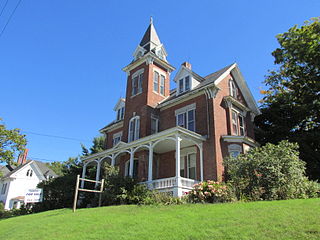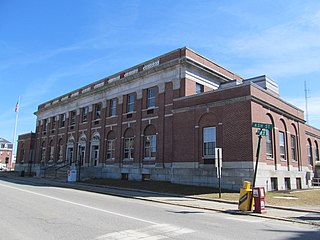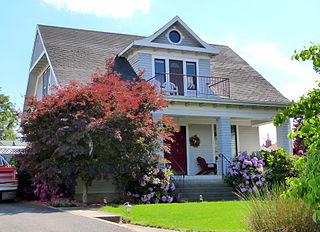
Rhodes Memorial Hall, commonly known as Rhodes Hall, is an historic house located in Atlanta, Georgia, United States. It was built as the home of furniture magnate Amos Giles Rhodes, proprietor of Atlanta-based Rhodes Furniture. The Romanesque Revival house occupies a prominent location on Peachtree Street, the main street of Atlanta, and is listed in the National Register of Historic Places. It is open to the public and has been the home of The Georgia Trust for Historic Preservation since 1983.

The F.F. Tomek House, also known as The Ship House or as the Ferdinand Frederick and Emily Tomek House, is a historic house in Riverside, Illinois. It is prominent example of Prairie School design by Frank Lloyd Wright. Designed in 1904 and construction finished in 1906, the Tomek House is a well-preserved example of the style. In addition to being a good example of the Prairie style, the Tomek house documents the development of the style, which reached its clearest expression in Wright's Robie House in 1908. It is included in the Riverside Historic District and was declared a National Historic Landmark in 1999.

The Senator William P. Frye House is a historic house on 453-461 Main Street in Lewiston, Maine. Built in 1874, it is a fine example of Second Empire architecture in the city, designed by local architects Fassett & Stevens for William P. Frye, a mayor of Lewiston and a United States Senator. The house was listed on the National Register of Historic Places in 1976.

The James C. Lord House is a historic house in Lewiston, Maine. Built in 1885 for a prominent local businessman, it is a high quality blend of late 19th-century architectural styles. It was listed on the National Register of Historic Places in 1978.

The Lewiston Main Post Office of Lewiston, Maine is located at 49 Ash Street in downtown Lewiston. Built in 1933 and enlarged in 1975, it is a fine local example of Colonial Revival architecture. The building was listed on the National Register of Historic Places in 1986 as U.S. Post Office–Lewiston Main.

The Main Street–Frye Street Historic District is a historic district comprising houses on Frye Street and parts of College Street and Main Street in Lewiston, Maine. This area was part of the most fashionable residential district of the city in the second half of the 19th century, and was home to many of the city's elite. Its architectural styles are diverse, with a significant number of homes designed by local architect George M. Coombs. The district was added to the National Register of Historic Places in 2009.

John Everett Tourtellotte was a prominent western American architect, best known for his projects in Idaho. His work in Boise included the Idaho State Capitol, the Boise City National Bank, the Carnegie Library, and numerous other buildings for schools, universities, churches, and government institutions. From 1922 to 1930, he worked in Portland, Oregon.

The former Chestnut Street Methodist Church is an historic church building at 15 Chestnut Street in Portland, Maine. Built in 1856, it is rare in the city as an early example of Gothic Revival architecture, and is one of the few surviving works of Charles A. Alexander, a popular architect of the period. The building was listed on the National Register of Historic Places in 1977. It now houses a restaurant.

The Skowhegan Fire Station is located at 16 Island Avenue in the center of Skowhegan, Maine. The fire station, built in 1904 to a design by William R. Miller, is one of the state's finest Romanesque Revival fire houses. It was added to the National Register of Historic Places on October 20, 1983.

The J. Nelson Kelly House is a building in Grand Forks, North Dakota that was listed on the National Register of Historic Places in 1994. The property is also known as Lord Byron's Bed and Breakfast and denoted as 32 GF 1387.It was built or has other significance in 1897. When listed the property included the house as the one contributing building and also one non-contributing building, which is a relatively modern garage.

The First Presbyterian Church at Locust and 1st Street, East in Lapwai, Idaho is a historic Presbyterian church built in 1909. It was added to the National Register in 1980.

The Gaylord Thompson House, in Lewiston, Idaho, was built in 1904. It was listed on the National Register of Historic Places in 1992.

The Frank Booth House, at 1608 Seventeenth Ave. in Lewiston, Idaho, was built in 1907. It was listed on the National Register of Historic Places in 1994.

The Nave Apartments, located on the 600 block of 8th St. in Lewiston, Idaho, were built in 1913. The building was listed on the National Register of Historic Places in 1978.

The Breier Building, at 631-633 Main St. in Lewiston, Idaho, was built in 1923. It was listed on the National Register of Historic Places in 1986.
James H. Nave was an American architect based in Lewiston, Idaho. He designed a number of works which are listed on the National Register of Historic Places (NRHP) for their architecture.

The Garfield School in Lewiston, Idaho, designed by J.H. Nave in Colonial Revival style and built in 1910, was listed on the National Register of Historic Places in 1982.

The Agnes M. Tamblyn House, at 1506 Seventeenth Ave., Lewiston, Idaho, was designed by Lewiston architect James H. Nave. It was built in 1905. It was listed on the National Register of Historic Places in 1994.

The William and Elizabeth McLaren House, at 1602 15th Ave. in Lewiston, Idaho, was built in 1904. It was designed by Lewiston architect James Nave. It was listed on the National Register of Historic Places in 1992.

The St. Stanislaus Catholic Church, at 633 5th Ave. in Lewiston, Idaho, was built in 1905. It was designed by Lewiston architect James H. Nave and was built by the Dubray Brothers. It was listed on the National Register of Historic Places in 1978.




















